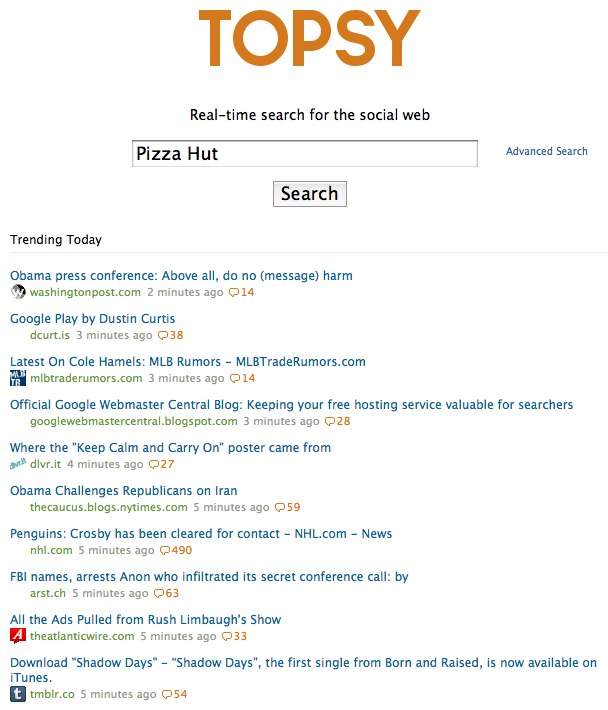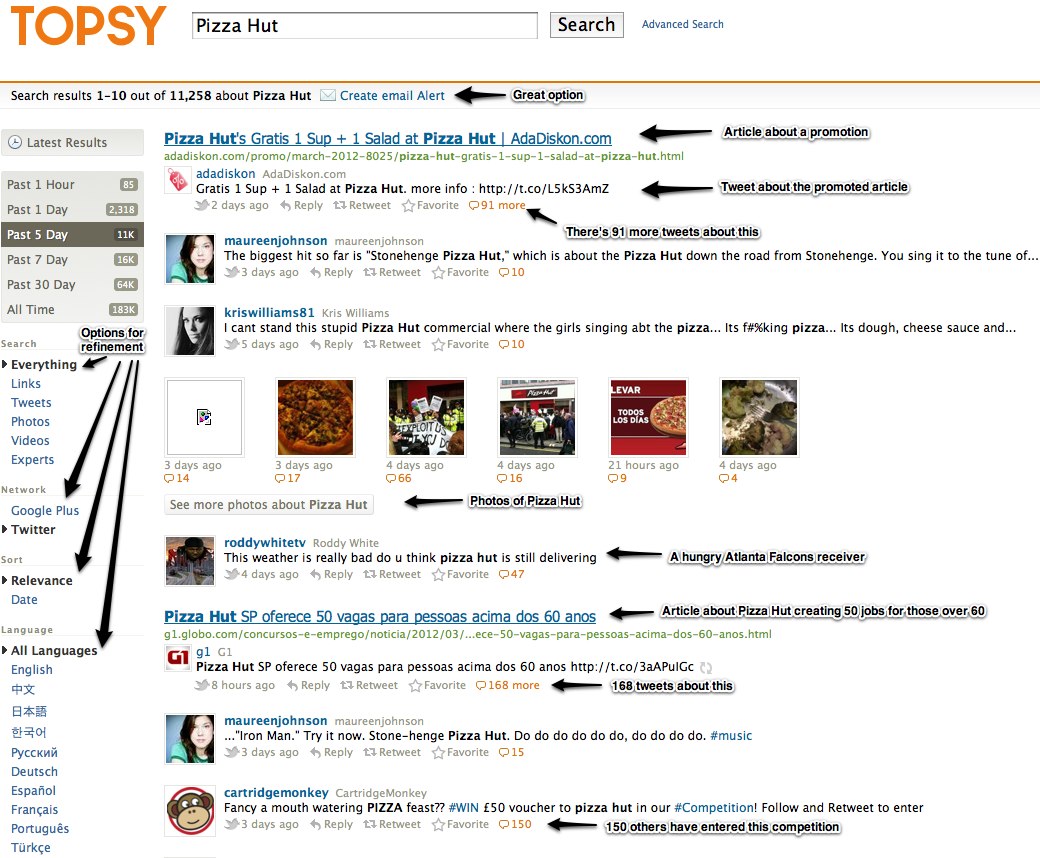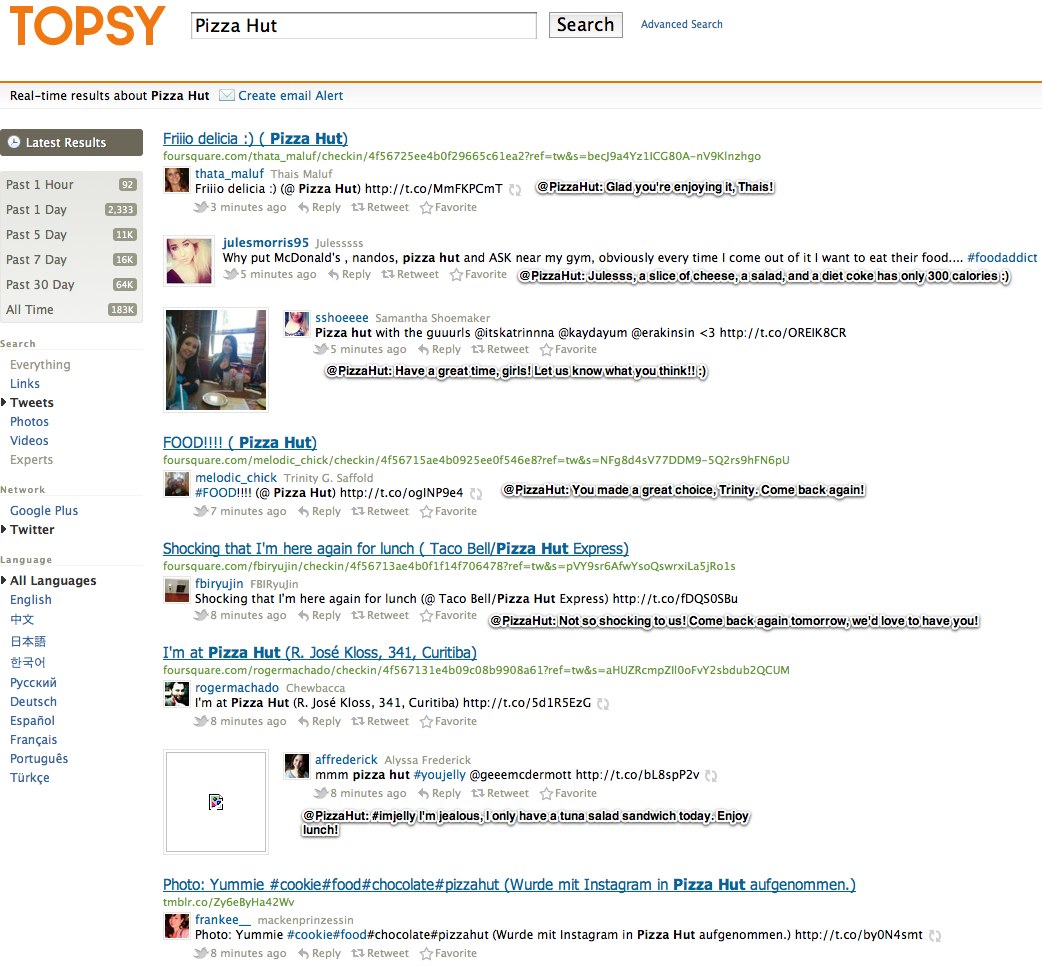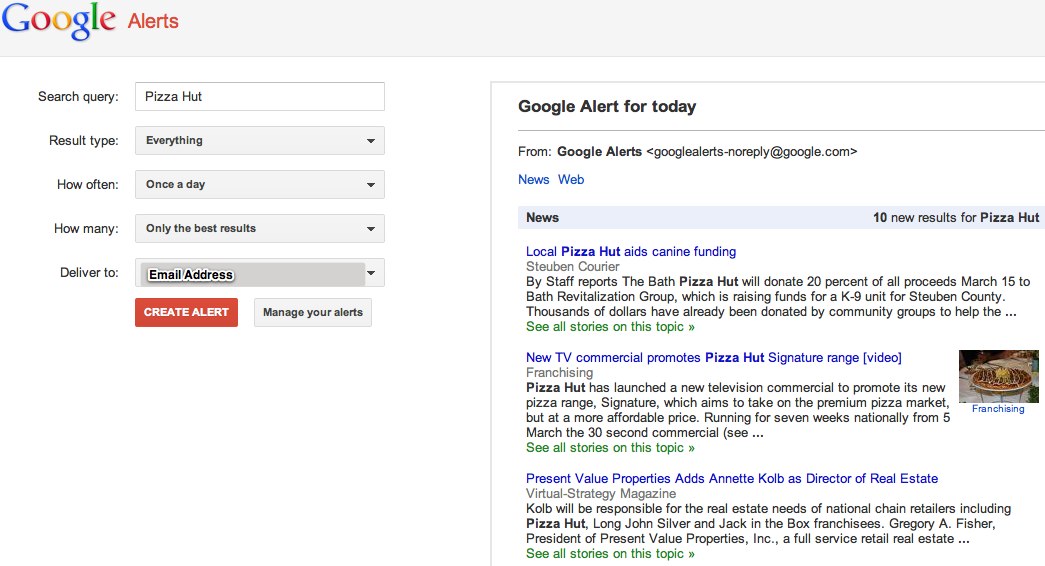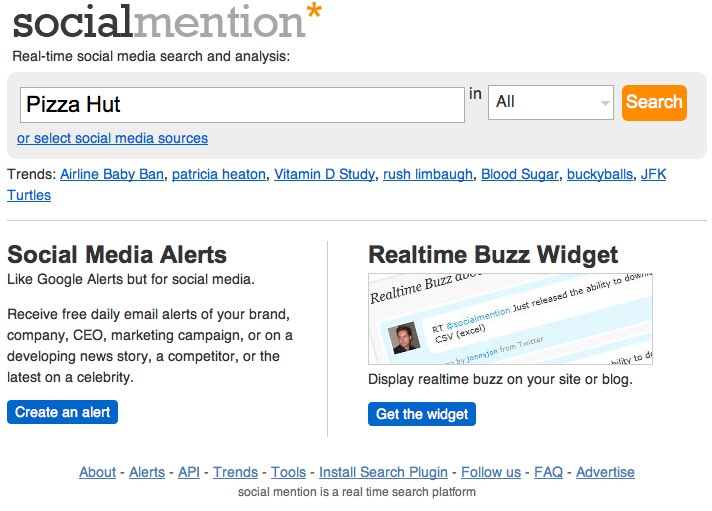How to Tell When People Are Talking About You Online (Part 2)

Using Pizza Hut as an example, this post will show you just how quick, free and easy it is to find out what your customers are saying about you on the Internet. PS: We like pizza. Especially, free pizza Mondays from Day Block Brewing Company.
Revised: November 5th, 2015
This is part two in a three-part series that will give you tips for easily monitoring your brand's reputation online. Tune in later for part three!
Part One covered how to find those that are linking to you online.
Part Two is going to cover how to monitor those that are talking about you, your brand, or your organization online.
Part Three focuses on those that tweet a link to your site, but don’t mention you via social media. That might sound a bit obscure, but we’ve found that it happens quite often.
So, on to part two.
I probably don’t need to explain the benefits of monitoring conversations about your brand that happen online, but for the sake of being clear, I’ll cover a few.
When potential customers drop your brand name, would you like to know? What if someone says something negative about your brand, service, or offering – wouldn’t you like to respond in a helpful, timely manner?
By using the following tools, tips, and tricks, you’ll be able to do this efficiently.
You’re probably thinking “Gee Scott, that sounds great and all, but I don’t have the cash OR the time to spend on such an endeavor.”
Worry not, dear reader. Most of the tools I personally use are automated alert systems that are completely free to use. These tools notify you automatically when someone speaks thy name. The only time commitments involve setup, physically reading the alerts, and if you so choose, taking action.
Some have a paid option which offers additional functionality, but the majority of what you’ll need requires no financial outlay of any kind.
Sounds good, right?
Well, to sweeten the deal, what if I were to tell you that you could use all of these tools to spy on your competitors? Would that be something you’d be interested in?
In all seriousness, you can use ALL of these tips to learn more about your competitor's social media activities. To keep with the theme of my example, you can monitor Dominos Pizza instead of Pizza Hut to see what they're doing online.
Let’s get to the contents of you monitoring tool-belt.
Here’s what I like to use:
1. Topsy
4. Followerwonk
Topsy
Topsy has a cute name, and serious functionality. They call their offering “Real-time search for the social web.”
For a grand total of $0, you can search Twitter, Google+, the entire Internet, and many more sources by selecting “Everything”.
Additionally, you can create email alerts, subscribe to an RSS feed of the results, or share the results on Twitter.
Let’s say I was Pizza Hut, and I wanted to see things people were saying about me online.
First, I’d go to www.topsy.com, and enter in Pizza Hut. As you can see, Topsy is already aggregating popular news and information based on what’s currently being talked about online.
Click search, and you’re brought to a results page. By default, you see results for “Everything”, sorted by relevance to your query. This can all be customized by the options on the left-hand column:
You see photos, tweets, articles that have been tweeted, etc. There are also 100 more pages of this, so there’s considerably more information. Again, these results are sorted by relevance to your query. If you’re looking for the most recent, you can either sort by date, or click the “Latest Results” option.
If I were on Pizza Hut’s social media team, I’d sort by “latest results”, and start interacting with people. It’s pretty easy to develop a message targeted to each user.
Here's how I would approach these:
You get the point. Topsy brings a massive amount of actionable information to the table, and it’s all on you for how you want to use it. They even censor swear words.
Google Alerts
As a lesser-known service of Google, Alerts don’t seem to get much love. However, there’s a ton of functionality in this tool. Basically, you input a query, and refine it via result types.
You can select Everything, News, Blogs, Video, Discussions, or Books. You set how often you want the alerts to be sent, how many, and your delivery preference (email or RSS feed).
TIP: Use Boolean operators such as AND, OR, site:[url] or –[excluded term] for further customization. More on Boolean operators here.
To use Google Alerts, simply go to www.google.com/alerts, and fill in your preferences. Based on your query, Google will automatically show you a preview of the alert that will be sent.
As your queries are found, Google will send you simple emails. Here’s what they look like:
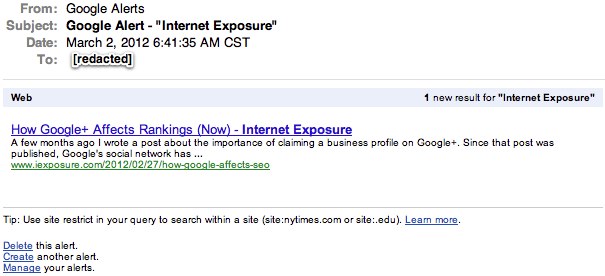
I’m just using one of our blog posts as an example. If you’re interested in seeing how quickly your content gets indexed, Google Alerts can help. In this case, our fresh blog post got indexed in about four days.
To sum it up, Google Alerts is a powerful and simple tool that anyone can use to keep tabs on a certain query.
Social Mention
Social Mention is quite similar to Topsy, but it offers some additional features such as more in-depth analysis on elements such as strength, passion, sentiment, and reach. Basically, it attempts to quantify qualitative data in a quality, quotable fashion.
Social Mention also offers email alerts, but the service appears to be offline for the moment.
To use Social Mention, simply go to www.socialmention.com, and enter your query.
Like Topsy, you’re able to refine your search based on type, and source. As you can see, I’m still using Pizza Hut as an example.
Click search, and you’re presented with a myriad of data. You see tweets, discussions on forums, photos, videos, and many other sources of data. Social Mention does not censor foul language, but I do.
Again, there are endless amounts of options for refinement here. You can view positive, neutral, or negative mentions. You can sort by date, source, and show results from pre-set timeframes. You can even view top hashtags used, and see who the top users are.
Also available for free are email and RSS alerts. You can segment and download the data into a CSV file. Basically, there’s no shortage of actionable information.
To act on this data, you can take the same approach as shown in the Topsy example above. I’ve added my own personal recommendation to the folks at Pizza Hut in the screenshot above.
Now, if you’re Pizza Hut, you might be thinking “Scott, this is all fine and dandy, but there’s so much information here – how do I prioritize my outreach?”
Well, Pizza Hut, I’m glad you asked. Enter Followerwonk.
Followerwonk
According to their Twitter profile,
“Followerwonk helps you explore and grow your social graph. Twitter analytics to find, analyze, and optimize for social growth.”
Sounds useful, right? It is. By combining user-level statistics with social analytics, you have a powerful cocktail of information at your disposal. Check it out for yourself - www.followerwonk.com. (Hat tip to Mike King)
For example, let’s take a look at this tweet, from the example above. Remember our hungry football player?
Roddy White is a Receiver for the Atlanta Falcons, and he has over 256,000 followers. I’m no expert, but I think that constitutes a high-priority.
Here’s a link to a report of Roddy White’s followers. (please leave me a comment if this link is dead, as I’m unsure as to how long it will remain live for.)
With Followerwonk, you can see any user’s influence scores, as well as detailed information about their followers.
You probably don’t need detailed statistics to determine that a professional football player with this many followers is influential, but I’m just going in-depth here for the sake of informational integrity. The key benefit of Followerwonk is that you can use this process to identify influential people that you weren’t aware of.
If Pizza Hut were monitoring mentions in real-time, they could immediately engage high-priority people such as this. The key here is to offer value.
Roddy is asking an incredibly simple question, and he’s hungry. He’s probably in Atlanta (based on his Twitter bio), so Pizza Hut’s social media team could check in with the Atlanta regional manager to make sure that they are making deliveries in inclement weather.
Then, engage.
A public realm such as Twitter is visible to all, and all it takes is Roddy to say something nice about Pizza Hut to immediately influence 256,000+ people.
The exposure from this single action can grow exponentially, as others see this and share it amongst their networks.
Well, that pretty much sums it up for today’s post. Hopefully you (and Pizza Hut) were able to get some actionable tips for kicking your social monitoring up a notch or ten.
If you have any questions, ideas, or tools that you like to use, please drop us a comment below! And if this post helped you understand brand monitoring, contact us to put a strategy into place that can help you manage your social customer service strategy.
The best way to stay tuned for Part 3 is to follow us on Twitter – keep an eye out for it!
Image by rdpeyton and licensed through Creative Commons.
